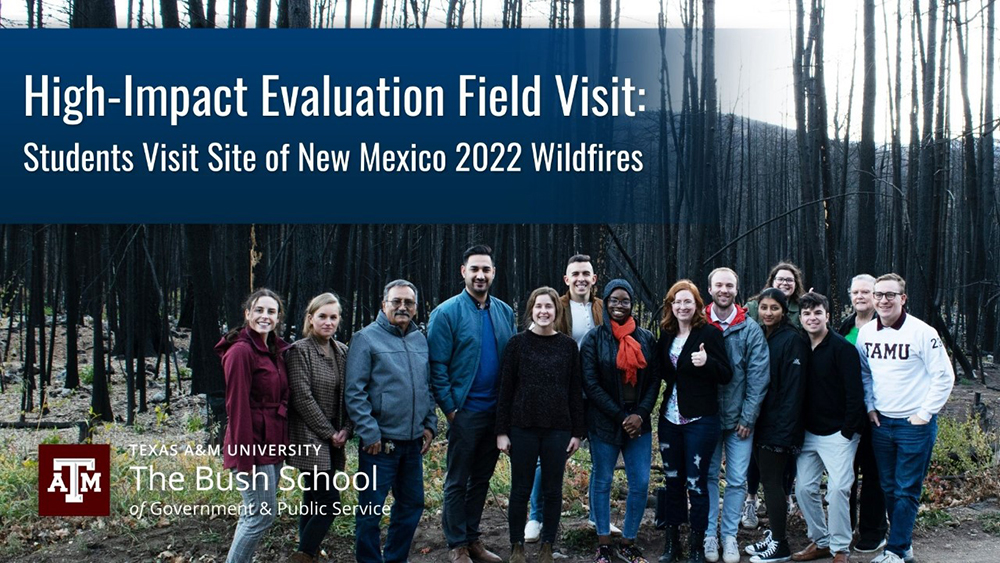
By Alexis Hixson
Since 2016, Dr. Silva Hamie, an Instructional Associate Professor in the Department of International Affairs at the Bush School of Government & Public Service, has taken students in her Post Conflict Recovery and Development course on an annual class field experience.
Video Recap: New Mexico High-Impact Evaluation Field Trip
Past field trips have included Louisiana, California, Florida and Port Aransas. This year, the students chose a new destination: New Mexico. Why New Mexico? In 2022, the wildfire season was among the worst natural disasters the state has ever experienced. In fact, the year marked New Mexico’s largest wildfire in recorded history, which burned over 300,000 acres and led to the evacuation of over 15,000 residences.
So, on Nov. 8, Dr. Hamie and 12 Bush School students began the annual class field experience – to study reconstruction efforts after the 2022 fire and monsoon seasons in New Mexico.
“The purpose of the class is to acquaint students with principles of disaster management, the phases of the responses, what the challenges are, who are the main actors, and so on…to actually talk to people in the field.”
Dr. Silva Hamie
“When I first started teaching here, I thought there was something missing. Not all students get to have the opportunity and chance to see things on the ground,” Dr. Hamie said. “So I addressed the issue with the Head of Department to see if there was a way to take students on a field trip to complement what we learn in class.”
The 2022 High Impact Evaluation field trip consisted of three days of field visits and interviews with disaster managers and responders at the federal, state, and local levels.
“The purpose of the class is to acquaint students with principles of disaster management, the phases of the responses, what the challenges are, who are the main actors, and so on…to actually talk to people in the field.” stated Dr. Hamie.

On the first day, the students visited the Department of Homeland Security (DHS) headquarters for a tour and a series of talks about the fire from each of the five full-time workers at DHS at the time of the fire. The DHS in New Mexico is responsible for coordinating response and providing government resources to those fighting the fire.
The class also visited Las Vegas County headquarters and Mora County, two of the counties most heavily impacted by the fires. Visiting Las Vegas County provided the students with a local-level perspective, highlighting the emotional challenges responders faced and how difficult it was for them to see the devastation to their community. Mora, the students were informed, is one of the poorest counties in the state. In Mora, the class visited with the newly reelected county commissioner, who described in detail the challenges that Mora County endured in attempting to get funding to fight the fires, and the challenges they expect to face as they rebuild.
“Many students have the belief that everything we do here in the U.S. is the best,” Dr. Hamie said. “It is interesting to see how shocked they are to learn of the miscommunication between the state and federal (government). That’s always the part that I like the most.”

Oluchukwu “Lulu” Nkenke, a Nigerian Master of International Affairs Bush School student from the Class of 2023, was fascinated by what the trip uncovered.
“This class has really opened my eyes. When I was in Nigeria, I heard that the United States is the pinnacle of hope, that they can handle everything, they can do everything,” Nkenke said. “So when I come here and I see the failure to take proper steps and proper management of natural disaster risk management, even though they have the resources and the facilities to actually operate it, it breaks my heart.”
The group was also hosted by the Sierra Bonita Fire Department and a member of New Mexico State Forestry, who provided a tour of the volunteer fire department’s facilities and a series of lectures from the Fire Chief and other firefighters.
On the final day, the students returned to the Department of Homeland security to hear a lecture from a FEMA representative about why disaster management matters. The FEMA rep tasked the students with completing a series of puzzles and games to simulate the chaos that ensues in disaster scenarios.
For many students, the most impactful part of the trip was a site visit to the forest impacted by the fires.
“The Department of Homeland Security took us literally into the forest. We were able to walk through the trees and walk through the ashy surface of the ground….It was very disheartening,” Nkenke said.
The annual experience in Dr. Hamie’s class has led many students to look towards careers in disaster response and recovery. Many students have gone to work in the development field.
“It is incredible to see how much damage that this natural disaster can cause, no matter how small or big it was. You can see how the response itself can make or break a town that this natural disaster took place in,” Nkenke said. “I feel like it really impacted what I want to do in my life. My main goal is to serve the community.”